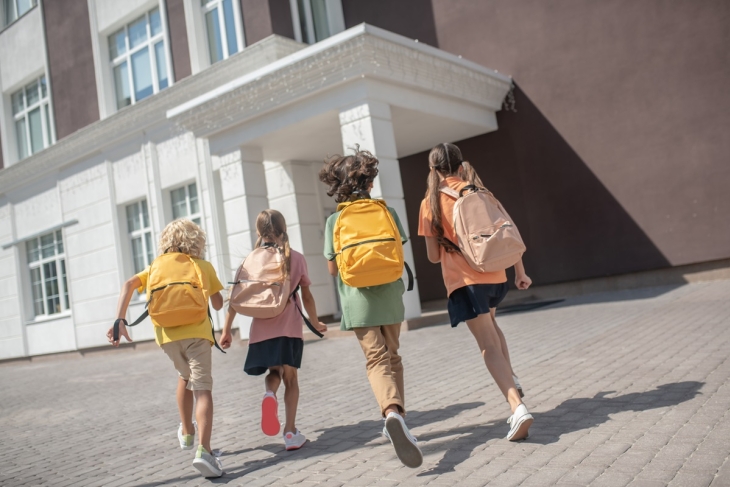Examination of Covid-era impacts on students, families, and schools continues apace. Getting a full picture of the fallout, who was affected, and how helps education leaders better direct their resources to serve impacted students. A recent report from NBER and Mathematica dives deep into pandemic-driven disenrollment from public schools in one state (Michigan) and the ways in which it bounced back—or didn’t—in successive years.
In the first year of Covid, an estimated 1.5 million K-12 students left public schools nationally for alternatives such as homeschooling and private schools. Other national data suggest that public school enrollment did not recover in 2021-22, and remained about 3 percent below pre-pandemic enrollment levels, but these overall data mask important variations across states. This study, which takes place in The Wolverine State—and unlike national analyses uses student-level data—details how enrollment changed before and after Covid, how exit rates compared to pre-Covid rates, and whether students who exited during the pandemic re-enrolled after 2 years. Included are Michigan students attending grades K—12 from fall 2017 to fall 2021.
First, the analysts provide overall enrollment data and trends: Before the pandemic, total enrollment had been declining by just under 1,000 students per grade annually, totaling more than 10,000 students per year. In fall 2020, total enrollment dropped by 3.2 percent, or 4 times the historic trend, and represented a single-year decline of more than 40,000 students. The fall 2020 enrollment drop was largest in Kindergarten, which declined by 11.3 percent. In contrast, enrollment in high school grades remained roughly in line with pre-Covid trends (although the latest national data show it increased about 2 percent between 2019 and 2022).
In the second pandemic year (fall 2021), enrollment continued to decline. Overall enrollment was 3.6 percent below pre-pandemic levels in fall 2019, which corresponds to an additional loss of 0.4 percentage points on top of the 3.2 percent decline in fall 2020. Kindergarten enrollment partially recovered from its steep decline in fall 2020, but remained substantially below fall 2019 enrollment. Other grade levels continued to decline only modestly, except for middle school, which saw enrollment drop by an additional 3 percent in fall 2021.
Next, the analysts describe exit rates in detail: Because only a small fraction of Michigan students enrolls in the public school system prior to Kindergarten, the declines in Kindergarten enrollment primarily reflect changes in initial enrollment. That is, the decrease is a result of parents holding back their kids from starting school during the depths of the pandemic rather than students exiting between pre-K and Kindergarten. In other grades, however, declines were largely driven by increased exit rates among students previously enrolled in public schools. But what proportion of those exits were subsequent reenrollments? 55 percent of those who exited before fall 2020 re-enrolled in public schools by fall 2021. This re-enrollment rate is highest among Kindergarten students: 62 percent who left the public school system (did not enroll in first grade) by fall 2020 re-enrolled in fall 2021. Return rates for other elementary and middle school grades are slightly lower at 56 percent, and the return rates are lowest among high school students, with only 40 percent returning. In contrast, re-enrollment rates in years prior to the pandemic were 24 percent lower on average and more stable across grades.
Digging further into re-enrollment by sector, analysts find higher return rates among those who left for homeschooling compared to those who left for private schools (the only sectors for which they have data). Approximately 50 percent of students who exited for homeschooling by fall 2020 returned to the public sector by fall 2021. In contrast, only 20 percent of those who exited for private schools returned. Both homeschooling exits and private school exits show the same pattern by grade level: relatively high returns among Kindergarten exits and relatively low returns among high school exits.
Compared to White students, Black students were more likely to return and Asian students were less likely. Low-income and special education students were also more likely to return in fall 2021, while English learners were less likely. The likelihood of returning decreased by grade level. Compared to Kindergartners who exited in fall 2020, students in grades 1-5 were 1.4 percentage points less likely to return in fall 2021. Middle school students were 4 percentage points less likely to return and high school students were 19 percentage points less likely to return.
As interesting as these findings are, they stop at fall 2021. Time has not stood still, so it is possible that more students have now returned to their public schools (in Michigan and elsewhere)—or not. Still, the trends documented in fall 2021 have bearing on where we now find ourselves in the 2023-24 school year. States and schools are responding to revised enrollments as they know them—and discussions about closures are ramping up. Coupled with the unavoidable fiscal cliffs, and the ongoing baby bust, numerous forces are bearing down on our public schools. Meeting the needs of both students who never left and those who returned is priority number one. Only then will the pressure let up.
SOURCE: Andrew Backer-Hicks et al., “The stickiness of pandemic-driven disenrollment from public schools,” Annenberg Institute at Brown University (August 2023).


